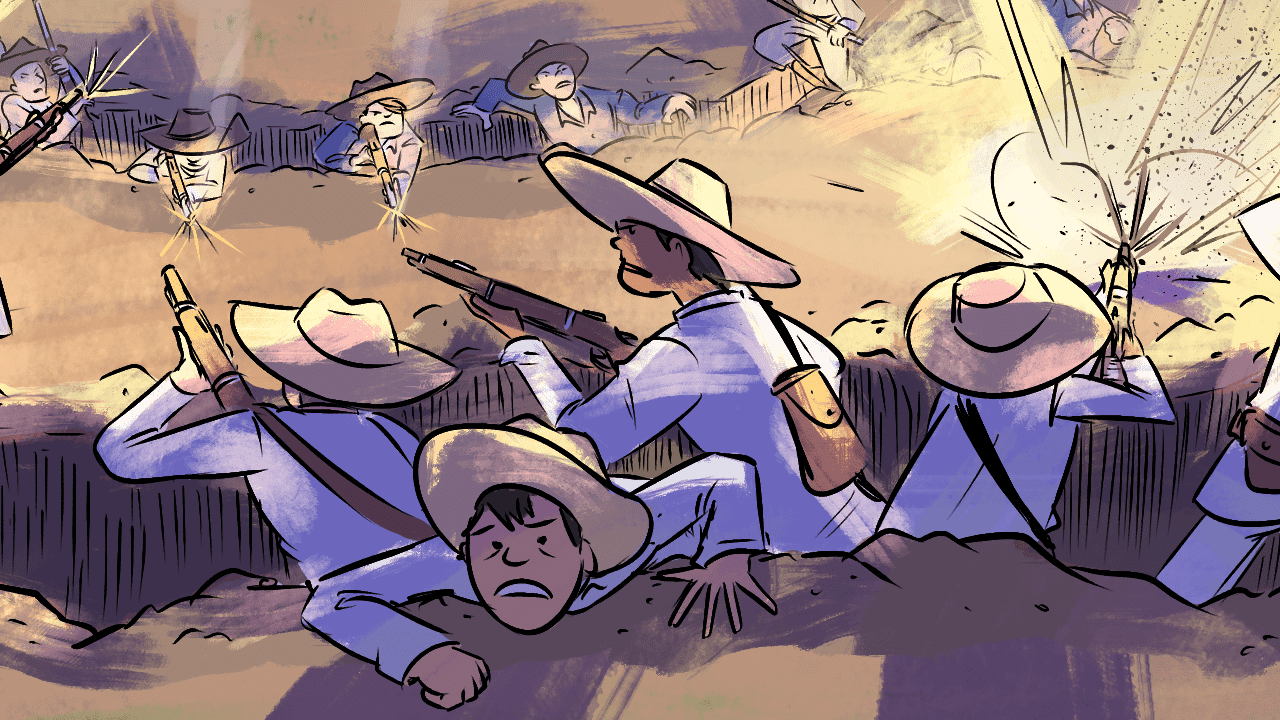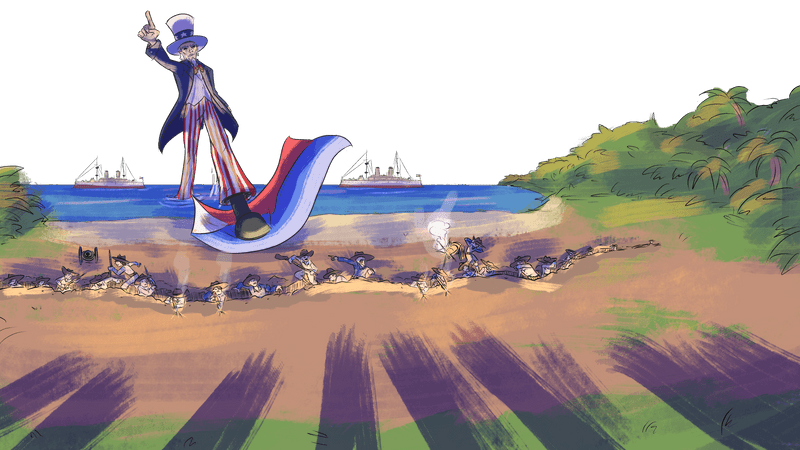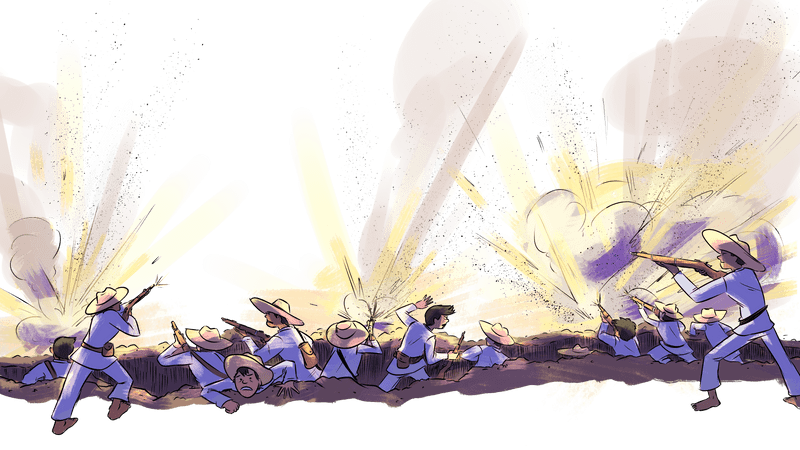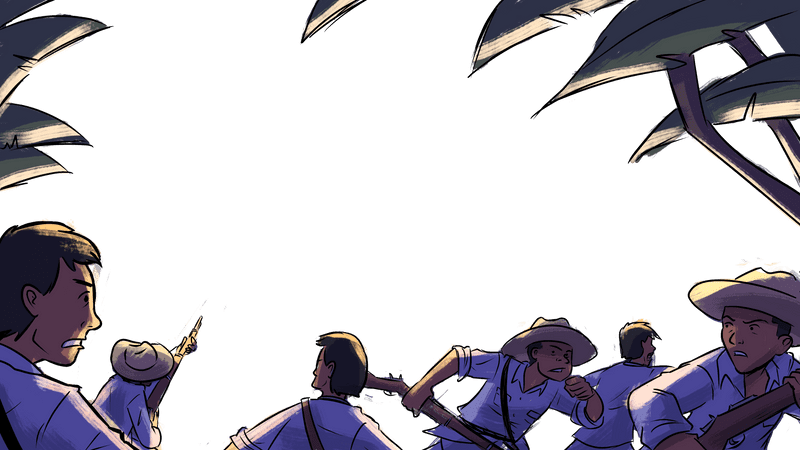Chapter One: Colonial Period
1898 – 1913
Philippine-American War
The United States had its eye on Spain’s colony in the Philippines.
Violence in Spain’s colony of Cuba prompted outrage in America. Many called for intervention, from humanitarians seeking to relieve the horrors of war to advocates of U.S. commercial and territorial expansion. After the mysterious explosion of the USS Maine in Havana in February 1898, the United States—led by President William McKinley and provoked by a sensationalist press—declared war on Spain two months later.
Most of the brief Spanish-American War took place in the Caribbean. But the United States also had its eye on Spain’s colony in the Philippines. In May 1898, Acting Secretary of the Navy Theodore Roosevelt sent U.S. warships into Manila Bay. In a brief, one-sided battle, Commodore George Dewey defeated the small Spanish Navy stationed there.
Revolutionary leader Emilio Aguinaldo hoped this would open the door for Philippine independence. At first, the Americans worked closely with Aguinaldo and his troops. U.S. diplomats and politicians made promises of independence and freedom to Aguinaldo and others. In the United States, a vigorous discussion over the country’s future ensued. Americans took sides in the debate about imperialism through speeches, pamphlets, and political cartoons.
Emilio Aguinaldo
March 22, 1869 – February 6, 1964
Military commander during the revolution against Spain and the United States
Aguinaldo ranks as one of the Philippines foremost national heroes. Born in 1869 in Cavite to a prosperous family, Aguinaldo led the revolution against Spain in 1895. Standing at a slender 5-and-a-half feet tall, Aguinaldo nonetheless rose quickly in the ranks to become one of the Katipunan’s most adept military commanders. During the colonial period, Aguinaldo organized the Association of the Veterans of the Revolution, a group that sought pensions and land for veterans. Under Japanese occupation, imperial forces convinced the aging Aguinaldo— who had worn a black bowtie for over 40 years to mourn his country’s defeat against the U.S.—to broadcast a radio address urging MacArthur and Filipino forces to surrender. After the war, he was charged with treason. Because Manuel Roxas would declare amnesty for Filipinos collaborators, Aguinaldo’s case never went to trial. Emilio Aguinaldo died in 1964, just shy of his 95th birthday.
President McKinley soon confirmed that the U.S. intended to acquire the Philippines permanently as a colony, a move ratified in the Treaty of Paris signed by Spain and the United States in December 1898. Filipinos were not permitted to attend or participate in the treaty negotiations that would determine their country’s future.
Oral History
“The official reason for annexation is to christianize and modernize the Philippines. But really it is about trade and empire.”
Dr. Colleen Woods, Historian, Professor at University of Maryland
Aguinaldo and other revolutionaries made clear they were going to win independence for the Philippines one way or another. On June 12, 1898, at the city of Cavite near Manila, the Filipino revolutionary government declared independence from the “yoke of Spanish dominion” and called for a “place in the concert of free nations.”
Seven months later, on January 12, 1899, leaders of the revolution gathered at the city of Malolos, north of Manila, and adopted a constitution for the independent Philippine Republic. The document unified a diverse archipelago of 7,000 islands, whose residents spoke dozens of languages and practiced a range of religions.
The Inauguration of the First Philippine Republic in Malolos, January 23, 1899. Fotografico Arias Rodriguez
The new constitution gathered Filipinos into the first republic in Asia. But Aguinaldo and his colleagues, including Apolinario Mabini, the author of the constitution, knew the obstacle to independence was not Spain, but America.
What began as a shared opposition to Spanish imperialism threatened to become a war between the United States and the new Republic. U.S. and Philippines forces stared at each other across opposing trench lines, dug during their war with Spain, as tension grew. All that was needed was a spark to light the fire.
“I have tried to avoid… armed conflict,” announced Aguinaldo. “but all my attempts have been useless.”
That moment came in February 1899, when a standoff at the San Juan Bridge just outside Manila ended with an American soldier opening fire on Filipino sentries. “I have tried to avoid … armed conflict,” announced Aguinaldo. “But all my attempts have been useless.”
The First Broken Promise
The next three years brought gruesome war between American and Filipino soldiers, and the devastation of towns, villages, and farms. Violence took the lives not only of some 4,200 U.S. troops and 15,000 Filipino soldiers, but of innocent civilians as well. Historians estimate that at least 100,000 and as many as 300,000 civilians died during or immediately after the war.
“The Samar Campaign was marked by wholesale killing of non-combatants, the elderly, children and women. The idea was to make the place into a 'howling wilderness.'”
Sandaan: One Hundred Years of Filipinos in America
Tens of thousands of American soldiers shipped out for Asia to take up the mantle of imperialism. Many were veterans of U.S. wars against Native American nations. Some had been in service since the U.S. Civil War. Two regiments of African American soldiers served in segregated units. Faced with imposing American power on the Filipino people, African Americans confronted the contradictions of race and empire head-on.
A handful deserted to join the revolutionary forces. Others wrote critical letters home for Black audiences. “Expansion,” one soldier wrote, “is too clean a name for it.” When another was asked what they were doing in the Philippines, he sardonically responded: “Assuming the white man’s burden.” Combined U.S. Army forces numbered over 70,000 by the end of the year.
One African American soldier wrote “Expansion is too clean a name for it.”
Aguinaldo, too, mobilized thousands of soldiers. Civilian sympathizers rushed to their aid with food and shelter. The war was brutal and long. American forces devastated the countryside, slaughtering livestock, burning crops, and imposing forced resettlement policies in their attempt to pacify the nation.
Large-scale resistance declined after the capture of Emilio Aguinaldo in 1901. In 1902, President Theodore Roosevelt declared victory in the Philippines, even though political and military opposition continued. Guerrilla violence persisted until the 1910s in some areas, especially in Mindanao, the Philippines’ southernmost region.
The war in the Philippines was America’s largest military action since the Civil War. It captured headline news at the time, and provoked bitter debate in the United States. There were concerns about the aims of U.S. foreign policy and methods of military conquest. In the years since, however, many Americans have forgotten or suppressed that history.
Filipino civilians detained by U.S. Soldiers during the war (1899). Keystone View Company
But it remains a vivid memory for Filipinos, who have treasured their independence struggle. When the U.S. left the Philippines in 1946, American officials set the Philippines’ national independence day on July 4. A few years later, Filipinos moved their independence day to June 12, the anniversary of the declaration of the Philippine Republic.
The war in the Philippines was America’s largest military action since the civil war.
Next Section
1902 – 1930s
Colonial Period
The U.S. colonial presence in the Philippines is shifted to a civilian colonization.
Explore



